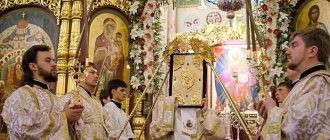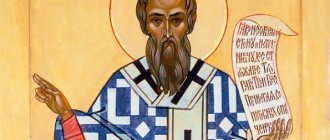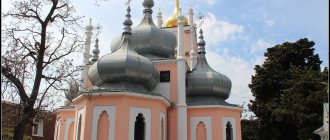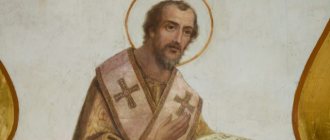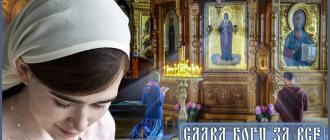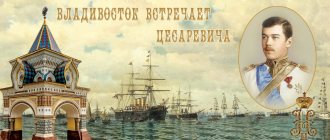The memory of St. John Chrysostom , Patriarch of Constantinople, is established annually on November 26 (November 13 according to the strict style) in honor of the anniversary of his accession to the archbishop's see. The holy fathers call Saint John Chrysostom “the mouth of Christ, the universal luminary, the universal teacher.” John Chrysostom was from Antioch. He studied with the best philosophers and rhetoricians. Since 398, John Chrysostom has been Archbishop of the Church of Constantinople. He was the greatest preacher and left us a great theological legacy. The works of John Chrysostom are recognized by researchers as the most important sources on the history of Antioch in the 4th century.
Priestly ministry of monk John and theological works
Saint John Chrysostom (Chrysostom), Archbishop of Constantinople, is one of the three Ecumenical Hierarchs. Born around 347 in Antioch , in the family of a military leader. His father, Secundus , died shortly after the birth of his son. John's mother, Anfisa , remained a widow at the age of twenty. She decided not to marry again, but to devote herself to raising her son in Christian piety. Young John studied with the best philosophers and rhetoricians of the time. One of his teachers was a representative of sophistry, the head of the rhetorical school in Antioch - Libanius (314-193). From an early age, John turned to the study of the Holy Scriptures and prayer. In 367, he received holy baptism from his mentor, Bishop of Antioch Meletius (d. 381). Three years later, John was ordained as a reader. In 372, Bishop Meletius was sent into exile by Emperor Valens (328-378). John, together with Theodore (c. 350-428; later Bishop of Mopsuestia), studied at the theological school of Antioch with presbyters Flavian and Diodorus of Tarsus.
When John's mother died, he took monastic vows. Soon John was considered worthy for the episcopal rank. However, he chose not to become a bishop. During this period John wrote his great work, Six Words on the Priesthood . He spent four years in the desert, where he created such works as “ Against those who take up arms against those seeking monasticism ” and “ Comparison of the Monk with the Tsar ” (“Comparison of the power, wealth and advantages of the king with the true and Christian wisdom of monastic life”), imbued with a high idea of dignity of monastic rank. For two and a half years he labored in silence while in a cave.
When John returned to Antioch, Bishop Meletius made him a deacon (381). John created such theological works as “ On Providence ” (“To Stagirius the Ascetic”), “ The Book of Virginity ”, “ To the Young Widow ” (two words), “ The Book of Saint Babylon and Against Julian and the Pagans ”. In 386, John was ordained a presbyter by Bishop Flavian of Antioch (320-404). Prester John became a brilliant preacher of the Word of God. For his gift of the God-inspired word, he received the name “ Chrysostom ” from the flock. For twelve years, twice a week, and sometimes daily, John preached in church to a large crowd of people. At this time, he wrote commentaries on a number of books of the Holy Scriptures and many conversations on individual biblical texts, as well as teachings on holidays, in praise of the saints and apologetic words (against the Anomeans, Judaizers and pagans). In addition, Prester John had concern for the poor: the Church of Antioch provided food daily for up to 3,000 virgins and widows, not counting prisoners, wanderers and the sick. At the beginning of Great Lent in 388, Prester John began an interpretation of the book of Genesis, which he completed at the end of October. During Lent, he delivered 32 discourses. During Holy Week he spoke about the traitor and about the Cross, during Easter Week and until Pentecost he preached daily sermons.
From Easter the following year, John began expounding the Gospel of John, and at the end of 389 he moved on to the Gospel of Matthew. In 391, the Christians of Antioch listened to his interpretation of the Epistles of the Holy Apostle Paul to the Romans and Corinthians. From 393 he turned to Galatians, Ephesians, Timothy, Titus and the Psalms. In a conversation on the Epistle to the Ephesians, John denounced the Antiochian schism: “I say and testify that to tear the Church apart means no less than to fall into heresy. The Church is the house of the Heavenly Father, One Body and One Spirit.”
Childhood and adolescence
Born in Antioch, into a noble family, around 347.
His father, Secundus, was a prominent military leader. He did not have time to have any strong influence on the upbringing of his son, since he died when John was still a small child.
John's mother, Anthusa, was a woman of noble birth. Widowed at the age of twenty, left alone with two children and an inheritance that required proper management, she faced considerable difficulties. In similar situations, many women, her contemporaries, did not refuse to enter into a second marriage, but Anfusa with firm determination rejected all marriage proposals that came to her. She found the strength to raise children and overcome other difficulties. Her high level of morality aroused sympathy even among pagans.
Anthusa's daughter, John's sister, apparently died soon after. As for John, his mother gave him perhaps the best upbringing that was possible given the circumstances.
Along with moral education, John received an excellent secular education. He studied philosophy from Andragathius, and literature, rhetoric (and other disciplines) from the famous Livaniya, one of the best specialists in the field of eloquence and oratory. During his studies, John surprised him more than once with his talents. Subsequently, Livanius spoke of him as the best student.
Probably, Anfusa, from childhood, confirmed her son, Chrysostom, in the truths of the Holy Scriptures. This helped him not to get carried away by pagan literature, not to fall under the spell of the gloss of secular pagan life.
Saint John Chrysostom - Archbishop of Constantinople
In 397, Archbishop Nektarios of Constantinople reposed. John was summoned from Antioch to be appointed to the see of Constantinople as archbishop. He began his archpastoral labors with the improvement of the priesthood. John donated the funds intended for the archbishop to maintain several hospitals and hotels for pilgrims. Archbishop John himself ate very sparingly and did not attend church feasts. He was involved in establishing Christianity not only in Constantinople, but also in Thrace, Asia Minor, and the Pontic region. John sent the most zealous Christian missionaries to preach in Phenicia and Persia. John wrote letters to Syria to restore the Marcionite Church, and achieved this. Preserving the unity of the Church, the saint did not allow the powerful Gothic military leader, who was dictating his terms to the emperor, to open an Arian temple in Constantinople. The saint put a lot of work into organizing a splendid Divine service: he composed the rite of the Liturgy, introduced antiphonal singing at the all-night vigil, and wrote several prayers for the rite of the blessing of oil.
Further development of personality
Soon after John received Baptism, Bishop Meletius elevated him to the rank of reader. At that historical stage, the position of reader often served as a preliminary step before accepting the priesthood.
Meanwhile, in 370, Meletius was expelled from the city due to the internal policies of Emperor Valens, who patronized the Arians and oppressed their stubborn opponents.
At that time, other famous teachers remained in Antioch: Carterius and Diodorus, who later became Bishop of Taras. In the school of this theologian, along with John, Theodore of Mopsuestia stood out for his knowledge. However, while Theodore sought to strengthen and even sharpen the features of Diodorus’ theology, John, on the contrary, tried to avoid extremes and smooth out the sharp corners.
Over time, John gained fame among local residents, who wanted to see him, like his friend Vasily, in a higher spiritual position. However, he himself, humbly considering himself unworthy of hierarchical elevation, resisted such desires. Meanwhile, his friend, Vasily, was consecrated to the episcopal dignity.
Around 374-375, after the death of his loving mother, John realized his long-standing desire and retired to one of the monastic monasteries. Here, in fasting, vigils and heartfelt prayers, he spent about four years.
Then, by the Providence of God, he withdrew and lived in a secluded cave as a hermit. The harsh ascetic life and constant exploits affected his physical health: the gastric disease he acquired haunted him until the end of his earthly life.
Having suffered from poor health, he was forced to leave his hermitage and return to Antioch. The year was 380.
Persecution of Archbishop John Chrysostom
Archbishop John denounced the licentiousness of the capital's morals, especially the imperial court. Empress Aelia Eudoxia (d. 404), wife of Emperor Flavius Arcadius (377-408), ordered the confiscation of the last property from the widow and children of the disgraced nobleman. Archbishop John interceded for the widow. But the empress did not yield and was angry with the archpastor. Her anger flared up even more when her ill-wishers told her that Archbishop John had her in mind in his teaching about vain women. The court, consisting of the hierarchs whom John had previously denounced, decided to deprive him of his rank and execute him for insulting the empress. But Emperor Arkady replaced the execution with exile. The people stood up for their archpastor. To avoid unrest, John himself gave himself into the hands of the authorities. That night a terrible earthquake occurred in Constantinople. Frightened Eudoxia asked her husband to return John from exile and sent him a letter begging for his return. But after a while, another denunciation awakens Eudoxia’s anger.
Saint John Chrysostom with his life. Icon of the mid-16th century. From the Fedorovsky Monastery of Pereslavl-Zalessky. PZIKHMZ
In March 404, an unrighteous Council was held, which decided to expel St. John. After the execution of the decree, the Church of Hagia Sophia and the Senate building burned down. Devastating barbarian raids soon followed. The slanderers fled to Alexandria. But after two months, a new denunciation awakens Eudoxia’s anger. And again in the capital’s church, the saint in a short speech blesses the Lord “for all His ways.” Eudoxia died in October 404. Even the pagans saw in these events heavenly punishment for the unrighteous condemnation of the saint of God.
Library of the Russian Faith Teachings in memory of St. John Chrysostom. Great Menaion of Cheti →
Read online in original
Bishop's career
In 397, after the death of the Archbishop of Constantinople Nektarios, John Chrysostom was summoned from Antioch and taken to the capital in order to transfer the orphaned see under his control. Moreover, the persons authorized to do this acted with ingenuity and cunning, not unreasonably fearing that the residents, who loved John as a shepherd, simply would not want to let him go.
Emperor Arcadius himself desired John's elevation to the See of Constantinople. This was desired by both the best part of the local clergy and the people. Despite the protests of envious people who intrigued about this matter and wanted to extract at least some personal benefit from it, in 397 John solemnly ascended the Patriarchal throne of Constantinople.
The Patriarch of Alexandria Theophilus, who resisted Chrysostom’s candidacy as best he could, who did not want to participate in his consecration, finally agreed, fearing possible punishment (as is considered for the actual offense(s) committed by him).
The task of serving in a new post, as required by the duties of a bishop, turned out to be very difficult. The general moral level of the inhabitants of Constantinople left much to be desired. The nobility was drowned in bliss and luxury, while the life of the lower strata was characterized by poverty and misery. The local clergy in many ways did not live up to their calling and purpose.
To turn the situation around, the new primate of the Church of Constantinople took the most decisive measures: he denounced the highest circles, expelled from the clergy clergy who had stained themselves with crimes and evasion of Christian duty, promoted reforms in the sphere of monastic life, and organized assistance to the poor.
Due to the desire for modesty in life, which was completely unusual for many of the representatives of the higher clergy, John aroused in them misunderstanding, and at times, outright discontent. He significantly reduced the cost of maintaining his department, limited his daily meals to a moderate range of products and dishes, and his everyday wardrobe to fairly modest (for his rank) clothes.
John Chrysostom spent the funds freed up as a result of prudent savings on charity. He also directed the funds he received from the sale of luxurious dishes, curtains, furniture, and marble to the needs of the poor.
The well-known opponent of the saint, Theophilus of Alexandria, being received by John at a modest table, took this reception as an insult, which is why his anger and hatred only intensified.
This behavior of John sharply contrasted with the behavior of other bishops and priests and served as a reproof for them. And this caused some tension. Over time, tensions developed into fighting.
Once John Chrysostom received four brothers from the Nitrian desert, who were seeking protection from the persecution of Theophilus. After listening to them, he turned to Theophilus with a petition. These actions were regarded by the latter as illegal interference in the affairs of another diocese. In turn, the monks began to seek protection from the emperor, turned to him and presented rather serious accusations against Theophilus.
He was summoned to Constantinople for trial. However, when the hearing of the appointed case took place, Saint John, guided by the best intentions, considered it appropriate to evade the trial. Theophilus, taking advantage of the situation, began to intrigue and accused Chrysostom of Origenism (this is due to the fact that the Nitrian monks he accepted were accused of Origenism).
The Council organized for this occasion, held at the villa “At the Oak”, provided by the king, included the Egyptian bishops who arrived with Theophilus. Theophilus's ally was the powerful Empress Eudoxia, dissatisfied with the fact that Chrysostom accused her of laying claim to the vineyard of one unfortunate widow, comparing her with the wicked biblical queen Jezebel.
At the Council, several slanderous accusations were made against John Chrysostom, who refused to come there, some of which were based on speculation, while others were based on false rumors. Among other things, he was accused of embezzlement of church funds (meaning the sale of valuables to them for the sake of charity).
Despite the intercession of ministers friendly to John, he was condemned. At the insistence of Eudoxia, Emperor Arcadius approved the sentence. The saint was deposed and sent into exile (not far from Nicomedia).
As soon as the news of what had happened spread through the streets of Constantinople, popular unrest occurred. Theophilus, for example, had to flee and secretly leave the capital.
Following the popular unrest, an earthquake occurred, which is why the empress, who was aware of her role in the condemnation of Chrysostom and considered the disaster a sign of God’s judgment, was horrified. After the exile returned from exile at the insistence of the empress, the townspeople gave him a solemn welcome. The newly created Council overturned the verdict of the previous Council, removed the charges against the saint and restored his rights.
However, soon the hidden hatred of his ideological opponents found another reason for gloating. When, not far from the Constantinople Church of St. Sophia, a column was erected in honor of Queen Eudoxia, and then, in honor of this event, celebrations were held that smacked of rude paganism and interfered with the course of the service with their noise, John Chrysostom turned to the prefect, pointing out to him the inconsistency of this action with Christian piety. Having not received a proper answer, he publicly denounced the empress, calling her a raging, raging Herodias.
This harsh reproof infuriated Eudoxia. However, she could not simply punish the High Hierarch of Constantinople. Then she again contacted Theophilus, urging him to bring another trial of the saint. Theophilus, fearing an outbreak of popular anger, did not dare to come to the capital in person, but sent a special embassy there: Akaki and Severin. The latter gathered the enemies of Chrysostom, after which a new verdict of deposition was passed by a joint decision. The emperor, succumbing to the influence of Eudoxia, confirmed the sentence.
Repose of Archbishop John Chrysostom
John, while in Armenia, strengthened his spiritual children in the faith. His numerous letters to the bishops of Asia, Africa, and Europe have been preserved. In 405 John fell ill. But his ill-wishers continued to commit outrages. An order came from Constantinople to transfer John to Pithiunt (Abkhazia). John made the transition, which lasted three months in rain and heat, under escort, being weakened by illness. In Comana his strength left him. At the crypt of St. Basilisk, consoled by the appearance of the martyr (“Don’t be discouraged, brother John! Tomorrow we will be together”), having received the Holy Mysteries of Christ, John with the words “Glory to God for everything!” passed away to the Lord on September 14, 407.
John was buried in Comana Pontica.
In 438, his relics were transferred to Constantinople. According to legend, during this event the people shouted with one voice: “Accept your throne, father!”, and the lips of the saint, lying incorrupt in the tomb, opened, and he exclaimed “Peace to all!” During the Fourth Crusade (1204), the relics of St. John were taken from Constantinople to Rome, and on November 26, 2004, by decision of Pope John Paul II, they were returned to the Church of Constantinople along with the relics of Gregory the Theologian and are stored in the Cathedral of St. George in Phanar.
Transfer of the relics of St. John Chrysostom to Constantinople to the Church of the Holy Apostles. Miniature Minology of Vasily II. Constantinople. 985 Vatican Library. Rome
John Chrysostom is the author of the liturgy of the Byzantine rite, which, according to the Charter, is celebrated on most days of the liturgical year.
Youth. Path to Church
Having received the necessary knowledge, John Chrysostom began practicing law and achieved brilliant success in this area. Thanks to his talent, education and high social position in society, he could build a good career. But God determined a different path for him.
Despite the fact that John's parents were Christians, he himself was not baptized in early childhood. At that time, the practice of postponing the Baptism of children was not considered something out of the ordinary. Many parents thought it was best if their children consciously joined the Church.
After some time, John, seriously fascinated by the Divine Scripture and the writings of the Church Fathers, interrupted his legal practice and left the title of rhetorician.
This decision was facilitated by the fact that Bishop Meletios of Antioch, seeing in him a potential servant of God and well understanding the benefit he could bring to the Church, called him to himself. For three years, John was instructed in the truths of Christian doctrine, and then received Baptism from Meletius.
By this time, John had finally formed a desire to devote his life to serving God. Many of his peers, who wanted to be closer to the Lord, then strove for monastic life, settled in deserted places, where they found wise mentors from among experienced ascetics, studied the word of God, prayer, contemplation, and physical labor. Monastic life could not be compared with life inside a large, noisy, corrupt city.
John, like many of his comrades, looked upon the monks with great respect. However, he did not go into the desert. This was facilitated by at least two factors: numerous requests from the mother, who saw joy in her only son, and the actions of Bishop Meletius.
Veneration of St. John Chrysostom. Troparion, Kontakion and Canon
John Chrysostom is revered among the three “ ecumenical teachers ” (together with Basil the Great and Gregory the Theologian), the celebration in their honor takes place on February 12 (January 30, old style). Remembrance days are also celebrated:
February 9 (January 27, old style) - transfer of the relics of St. John Chrysostom (from Comana to Constantinople);
September 27 (September 14, old style) - repose of St. John;
November 26 (November 13, old style) is the day of St. John Chrysostom, Archbishop of Constantinople (the anniversary of his accession to the archbishop's see).
Troparion and Kontakion to St. John Chrysostom
Troparion, tone 8.
From your lips is like a radiant dawn, the grace given by God to you, enlightening the universe. Do not lay down the treasure of the world for money, but show us the height of humility of mind, and chastising Father John Chrysostom with your words, pray to the Word of Christ God, to save our souls.
Kontakion, tone 6.
We receive Divine grace from heaven, and with our lips teach all to worship the one God in the Trinity, John Chrysostom, the all-blessed reverend, we worthily praise you, for you are a mentor, as you are shameless.
Library of the Russian Faith Canon to St. John Chrysostom →
Read online
Library of the Russian Faith Canon for the Translation of the Relics of St. John Chrysostom →
Read online
Saint John Chrysostom. Icons
The oldest surviving images of John Chrysostom are in the church of Santa Maria Antiqua in Rome (frescoes from the mid-7th and mid-88th centuries) and in the chapel at Khirbet el-Mard (7th century).
The iconography of St. John Chrysostom is almost no different from the general iconography of saints. But in Byzantine times it had one peculiarity: the saint was painted with a cross - a sign of martyrdom. But, as you know, the saint suffered not from pagans or heretics, but from his own brothers in faith. And this cross in the era of the Byzantine Empire was a reminder that martyrdom is possible not only in the era of persecution.
Saint John Chrysostom. Greece. XIV century, Vatopedi Monastery
Images of the saint became widespread in church art. In Russian icon-painting originals, the iconography of John Chrysostom is described as follows: “... the brada aka Cosmas the Unmercenary, a little oversize, sparse, hair on the head of the russian, a little curly, the forehead is high, wrinkled, the robe of the saint, sakkos cinnabar, in the crucis there are golden crosses, underside is green, by hand blesses, and in the other a book.”
Saint John Chrysostom. Mosaic of St. Sophia Cathedral in Kyiv (XI century)
Saint John is revered as the creator of the edition of the Liturgy, the most widespread in the Orthodox Church, and therefore his image can often be seen in the church in the Altar or in the iconostasis in the priestly rank along with other Fathers of the Church.
John Chrysostom. Last quarter of the 14th century. From the Deesis rank. Annunciation Cathedral of the Moscow Kremlin, Moscow
John Chrysostom. 1425–1427 Trinity Cathedral of the Holy Trinity Sergius Lavra, Sergiev Posad
Saints John Chrysostom and Basil the Great. First half of the 16th century. Vologda lands, fragments of the Royal Doors
|
|
Temples in the name of St. John Chrysostom
One of the oldest monasteries in Moscow , located on Bolshoy Zlatoustinsky Lane, was consecrated in the name of John Chrysostom The first mention of the monastery dates back to 1412. During the Soviet period, the monastery was destroyed.
View of the Chrysostom Monastery, 1882
was built in Kostroma . The first mention of it dates back to 1628. At the beginning of the 17th century, on this site there was an ensemble of two wooden churches - a “winter” one in the name of the holy martyrs Florus and Laurus and a “summer” one in the name of St. John Chrysostom. In the 17th century, the wooden church of St. John Chrysostom was rebuilt, and in the middle of the 18th century a stone church was built in its place.
Church in the name of St. John Chrysostom in Kostroma
was consecrated in the name of John Chrysostom . According to the Klirovy Gazette, the temple was built in the 17th century. The church is two-story, i.e. consists of two rooms: the lower and upper churches. The throne of the upper church was consecrated in the name of John Chrysostom, the throne of the lower church - in the name of the Holy Myrrh-Bearing Women.
Temple in the name of John Chrysostom in Vologda
A chapel in the Kidron Valley (Judean Desert) of Israel was consecrated in the name of John Chrysostom . The chapel itself was apparently converted from the residential cell it was originally.
Chapel in the name of John Chrysostom in the Judean Desert
Old Believer churches in the name of St. John Chrysostom
Old Believer churches (ROC), consecrated in the name of St. John Chrysostom, are located in Tula and Yaroslavl.
Temple in the name of John Chrysostom in Tula. Years of construction: 1903-1913
Temple in the name of John Chrysostom in Korovniki (Yaroslavl). Years of construction: 1649-1654

